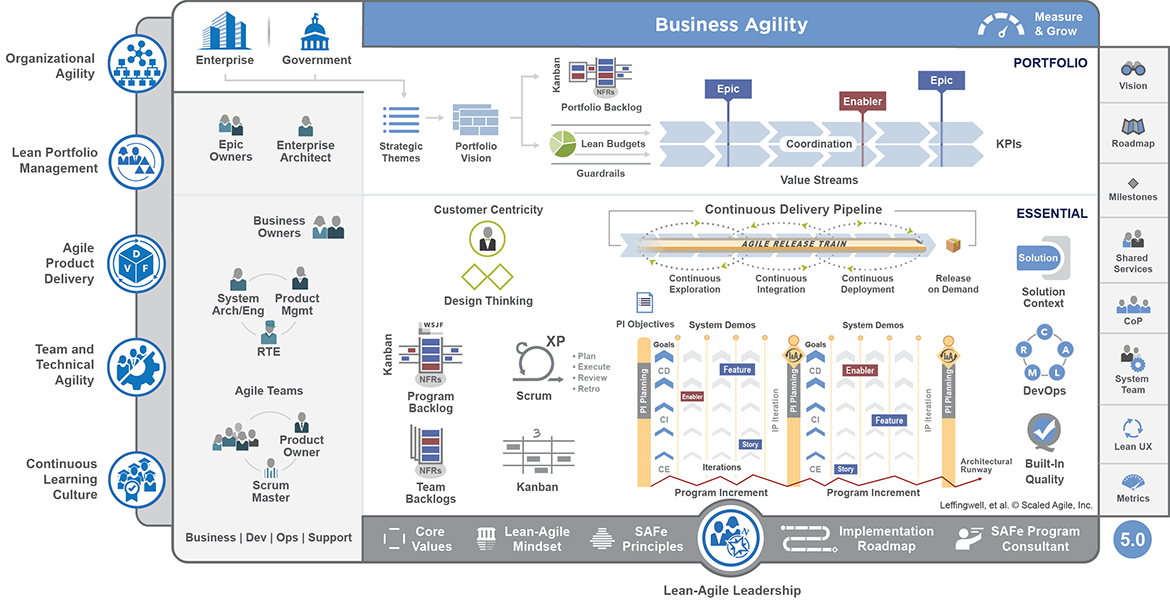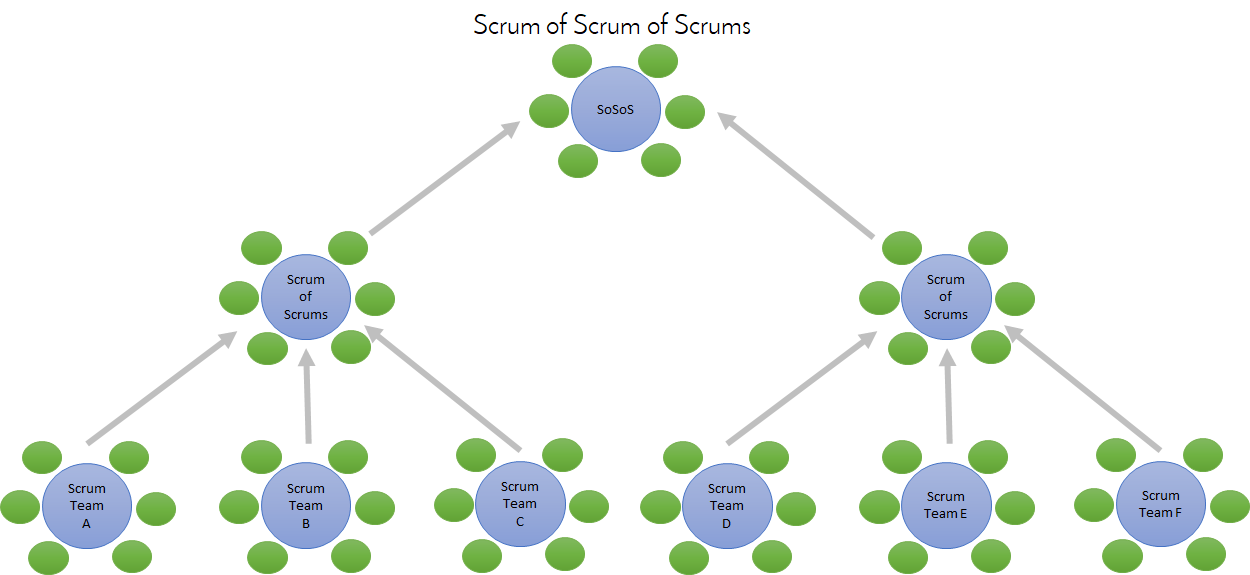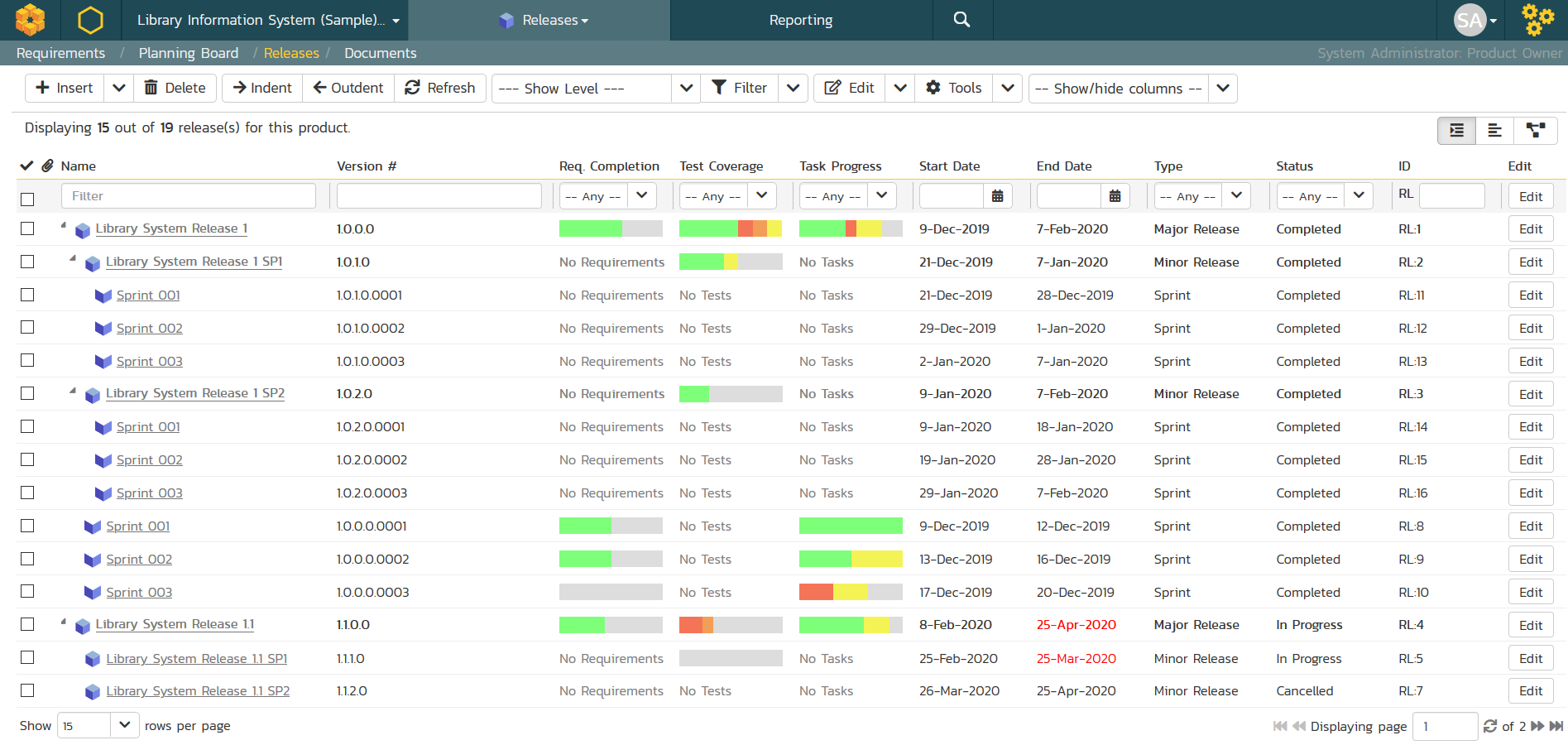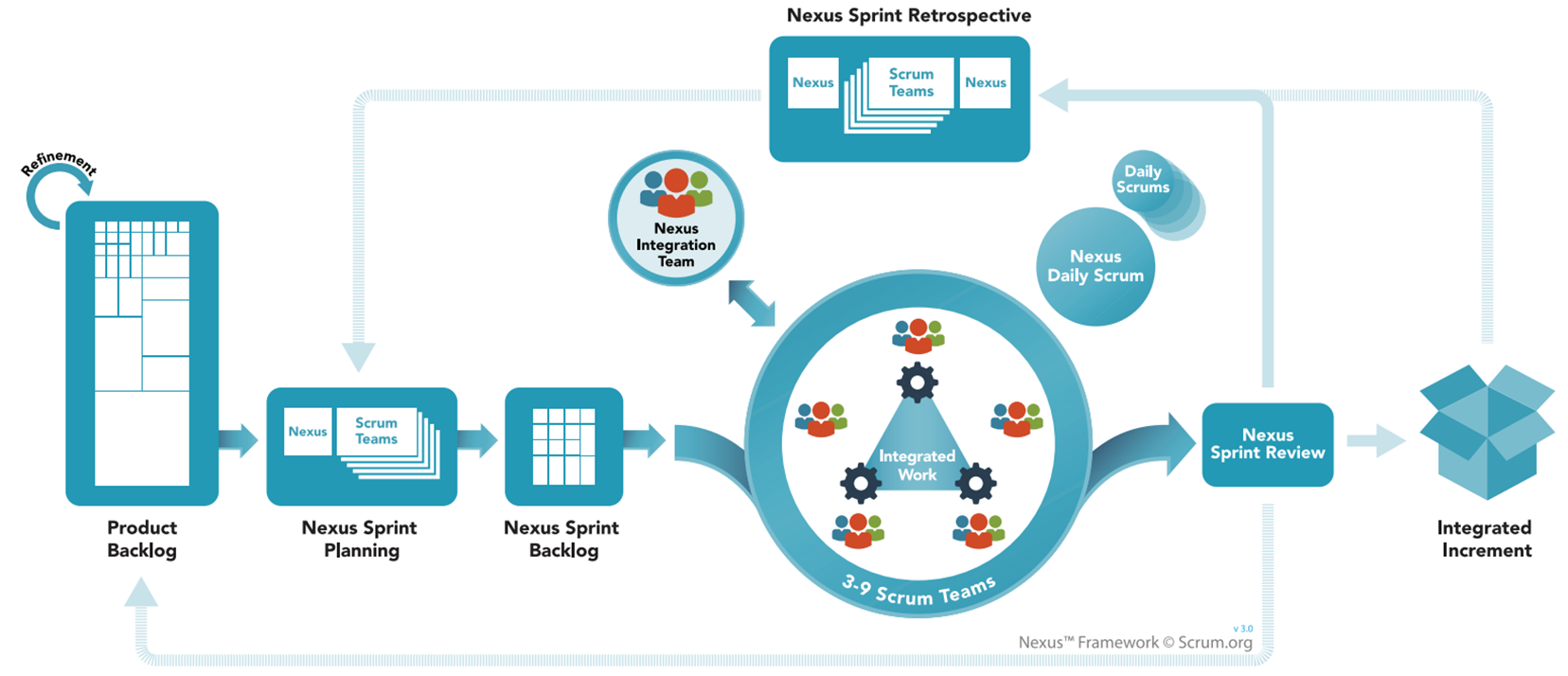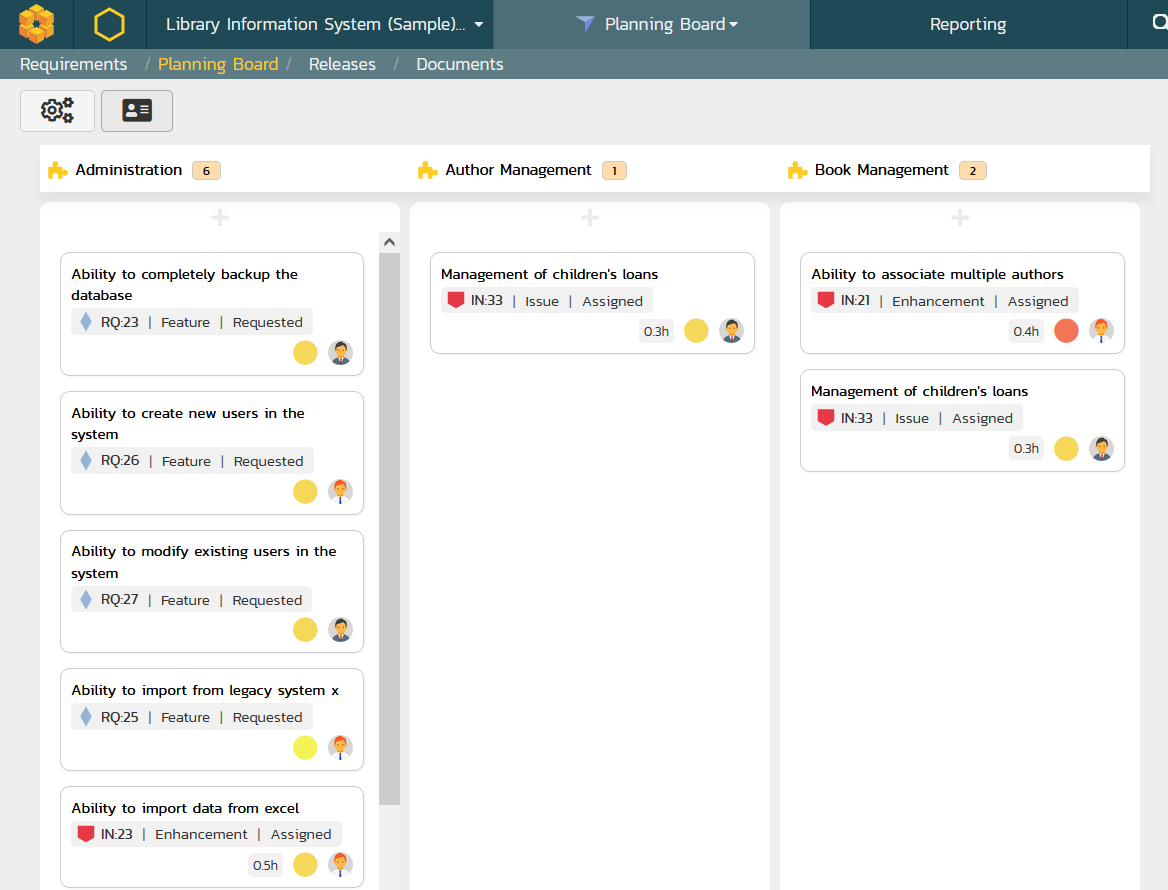Scaled Agile Framework (SAFe)
Because one of the limitations of standard agile methodologies is that they are designed to primarily operate at a team level, the scaled agile framework has seen a recent boom in popularity. It uses several core values and principles to align cross-functional teams throughout a large organization, making it more appealing to larger organizations. However, it does this without losing the key benefits of agile methodologies such as speed and focus on customer feedback.
What is Scaled Agile? SAFe vs. Agile
As the name implies, the primary difference between our traditional agile methodologies and this scaled agile framework is the size of the organization that each was designed for. Agile was largely developed for relatively small teams working on a specific project. Scaled agile framework is engineered with enterprise-level organizations in mind, mitigating some of the challenges that are inherent to larger teams. Its guidance includes documentation and responsibilities for specific roles, recommendations for planning and managing deliverables, core values to abide by, and more.
SAFe Agile Core Values
When it comes to the foundation of scaled agile, it’s built on four core values. Everything within the framework comes back to alignment, built-in quality, transparency, and program execution:
- Alignment - whether it be goals, objectives, or priorities, all are aligned across all levels of the organization, from the individual to the enterprise.
- Built-in Quality - the framework emphasizes the importance of building in quality at every stage of the development process, from design to testing.
- Transparency - this is also encouraged through communication and decision-making, with a focus on openly sharing information and actively seeking feedback.
- Program Execution - the priority should always be to deliver value to the customer through rapid iteration and continuous learning.
Scaled Agile Principles
Built on these core values are the nine principles that scaled agile follows. These apply to processes, but also extend to intangible factors such as knowledge and motivation:
- Take an economic view of the organization’s work, focusing on maximizing value and minimizing waste.
- Apply systems thinking to understand the relationships between different parts of the organization and how they work together.
- Assume variability and preserve options, and design systems that are flexible and adaptable in the face of change.
- Build incrementally with fast integrated learning cycles to build and deliver value in small increments, and continuously improve and adapt.
- Base milestones on objective evaluation of working systems, rather than on subjective opinions or predictions.
- Visualize and limit work-in-progress, reduce batch sizes, and manage queue lengths to improve flow and reduce waste.
- Apply cadence and synchronize with cross-domain planning to align across different levels of the organization.
- Unlock the intrinsic motivation of knowledge workers by giving them the autonomy, purpose, and opportunity to learn and grow.
- Decentralize decision-making within teams’ areas of expertise and responsibility.
Using these core values and principles will help your organization adopt and implement scaled agile practices and framework, setting you up for success.
Benefits & Applications of Scaled Agile Framework
But why should you consider a scaled agile framework for your company? As mentioned earlier, agile methodologies such as eXtreme Programming and Scrum were originally designed for small integrated teams of approximately 5-10 people (or even pairs) working together on a single solution or product. As the benefits of agile methodologies (early feedback, continuous integration, seamless communication, and cross-discipline teams) have become apparent to larger organizations, there is a need to scale agile from its original roots to support larger initiatives and programs.
Baseline: Individual Teams
If you consider a typical cross-functional agile team, there will often be a mix of developers, UX/UI designers, and testers (automated and manual). You may also have other specialized roles (e.g. database administrator, aka DBA), security engineer, performance engineer, etc.) depending on the nature of the project.
In the middle is the product owner who works with the customer to understand the requirements (user stories, etc.) and the Scrum Master who is focused on the team and its operations. This arrangement works well for a single team, working on a single independent system or project.
Scaling to Team of Teams
The first step up in terms of scaling agile is the ability to have multiple teams working on either different modules of a larger, integrated system (called a product), or multiple different projects that have a common set of business objectives (called a program).
In the case of a program, you will have multiple Scrum teams that work on different projects, with a Program Management Office (PMO) in charge of coordinating the different teams that comprise the program. If you have a single, large, integrated project/system, then it would be a Project Management Office instead. Please note that although the same abbreviation, PMO, is noted for both Project Management Office and Program Management Office, their role and responsibilities are not the same.
Scaling to Programs & Portfolios
Next, you may need to coordinate the development and release of multiple separate products (or programs). These often have interdependencies, shared resources, elevated risk dependencies, and associated governance for decision-making, or simply a common organizational reporting structure. For example, you might have one executive in charge of the rollout of a new online banking portal, mobile banking application, and related marketing updates to the website.
This grouping of products and programs is typically called “a portfolio”. Project Portfolio Management (PPM) is the centralized management of the processes, methods, and technologies used by portfolio, program, product, and project managers. They use this to analyze and collectively manage current or proposed projects based on numerous key characteristics.
PPM provides portfolio, program, and project managers in large, program/project-driven organizations with the capabilities needed to perform integrated change control while managing the time, resources, skills, and budgets necessary to accomplish all interrelated tasks. It provides a framework for risk mitigation and issue resolution, as well as centralized visibility to assist with planning and scheduling.
Scaling to the Enterprise
The next level of scaling agile, is to the entire enterprise, with the agile teams working in product groups and/or programs, organized into portfolios. This enables the company to deliver on its strategy and business objectives, while supported by the infrastructure, culture, and core values of the organization.
In this context, the agile teams will be providing high-level metrics and key performance indicators (KPIs) to the executive team of the organization. Not only that, but they will provide equally important metrics to supporting shared services such as IT, HR, marketing, staffing, and customer support, so that the entire enterprise can deliver on its promises.
For example, knowing that a specific feature is on track for release by a certain date will impact the marketing of that feature, the training of customer support agents, upgrades to IT infrastructure, as well the ability to meet company financial targets.
Beyond the Enterprise
Finally, the ultimate scaling of agile development is when multiple organizations are interconnected to form a “software supply chain.” This could include software features, requirements, and feedback being shared backward and forwards between companies that make products, their suppliers, customers, and subcontractors.
In this context, the supply of value from idea creation to product delivery is no longer restricted to the organization itself. One company is a supplier of products that are used as a component in the product of its customer, sowing the seeds for “value co-creation.”.
Types of Scaled Agile Framework
There are a number of different variations of scaled agile frameworks that organizations can implement for their development approach. While the most common and most well-known is SAFe, there are other useful iterations that are worth discussing as well:
Scaled Agile Framework (SAFe)
The most common implementation of scaled agile is the SAFe methodology. The Scaled Agile Framework (or SAFe) is a software development framework that takes the concepts of agile development and provides a “larger picture” methodology that allows you to use agile approaches across an entire enterprise.
(Image is Copyright Scaled Agile Inc).
Within the SAFe variation, there are four main configurations (for use in different contexts):
- Essential SAFe is the most basic configuration. It describes the most critical elements needed and is intended to provide the majority of the framework's benefits. It includes the team and program levels.
- Large Solution SAFe allows for coordination and synchronization across multiple programs, but without the portfolio considerations.
- Portfolio SAFe includes concerns for strategic direction, investment funding, and lean governance.
- Full SAFe combines the other three levels into a single methodology.
For a deeper dive into SAFe and these individual configurations, see our guide here.
Or, see our list of the best SAFe tools.
Large Scale Scrum (LeSS)
Large-scale Scrum (LeSS), as the name suggests, is a product development framework that extends Scrum with scaling rules and guidelines without losing the original purposes of Scrum.
(Image is copyright The LeSS Company B.V.)
There are two levels to this framework:
- The first LeSS level is designed for up to eight teams
- The second level, known as “LeSS Huge,” introduces additional scaling elements for development with up to hundreds of developers.
The intention of LeSS is to “descale” organization complexity, dissolving unnecessary complex organizational solutions, and solving them in simpler ways. Fewer roles, less management, less organizational structures.
Some key features of LeSS that distinguish it from some of the other scaling approaches:
- No central integration team, project management office (PMO)
- No shared services or support groups such as DevOps, IT, testing (they’re all embedded within the existing cross-functional agile teams)
Typically, LeSS teams are organized into groups that have one owner per product, with multiple feature teams under the single product owner. Each of them will have its own scrum master.
SpiraPlan includes easy-to-use product, release, and sprint boards that let you see all of the features and defects planned for each feature team in the product backlog.
Scrum at Scale (S@S)
Scrum at Scale was devised by Jeff Sutherland, co-creator of Scrum. Similar to LeSS, it leverages the basic principles of Scrum and applies them to larger and more complex organizations (hence the “at scale”). The emphasis in S@S is being flexible and modular, enabling teams to customize the framework to their needs while scaling across multiple groups and departments. This facilitates alignment between teams and business objectives, promoting a unified approach to achieving goals.
Disciplined Agile (DA)
Disciplined Agile is a lightweight framework that combines several agile and lean approaches, providing guidance on how to integrate them effectively. DA is highly adaptable, supporting multiple lifecycles and offering guidance for different types of teams and projects. Over time, organizations can refine their approach based on feedback and evolving needs, continuously improving their processes.
Scrum of Scrums (SoS)
The Scrum of Scrums is another technique to operate Scrum at scale, for multiple teams working on the same product. It allows them to discuss progress on their interdependencies, focusing on how to coordinate delivering software, especially on areas of overlap and integration.
Depending on the cadence (timing) of the Scrum of Scrums, the relevant daily scrum for each scrum team ends by designating one member as an ambassador to participate in the Scrum of Scrums with ambassadors from other teams. Depending on the context, the ambassadors may be technical contributors or each team's Scrum Master.
The SoS framework typically is employed at multiple levels, and within a platform like SpiraPlan, you have two main approaches you can follow:
- Have the entire SoS hierarchy managed in a single product, using the flexible release-sprint hierarchy to handle multiple levels
- Have the top-level SoS hierarchy managed as a program with each product containing a hierarchy of releases for the lower levels of aggregation
SpiraPlan makes this approach especially fluid with its support for multiple levels of releases and sprints, each of which can roll up its progress and metrics to higher levels:
The Nexus Model
Nexus extends Scrum to guide multiple Scrum Teams on how they work together to deliver working software in every Sprint. It shows the journey these teams take as they come together, how they share work between teams, and how they manage and minimize dependencies.
(Nexus™ framework diagram is copyright Scrum.org)
Nexus is a simple framework that can be applied to 3-9 scrum teams who are working in a common development environment, and are focused on producing a combined increment every sprint with minimal dependencies.
The core of the Nexus framework is the Nexus Integration Team which consists of a Product Owner, Scrum Master, and one or more members from each Scrum team. SpiraPlan provides the perfect tool for managing the individual Scrum teams and the Nexus integration team with its support for product backlogs, multiple releases per product, and program-level backlogs.
Why Choose SpiraPlan for Scaled Agile/SAFe?
Now that we’ve looked at the reasons for scaling agile, as well as the different levels in which it can be scaled, what tool should you use to implement it for your organization?
Key Differentiators
The top reasons that our customers choose SpiraPlan over other solutions are:
- It is a complete solution that includes requirements management, release planning, iteration planning, task estimation and defect tracking, all fully integrated from day one.
- Provides Integrated Program Backlogs that let you plan program-wide capabilities that includes features from multiple projects and track them against program milestones.
- Methodology Agnostic and can be used equally well for any scaled agile software development methodology – including SAFe, Nexus, Scrum of Scrums, DA, and LeSS.
- Ability to leverage your existing technology investments. SpiraPlan integrates with many third-party defect-management systems and source code management systems, and DevOps pipeline tools.
We also provide unmatched technical support that answers any questions or concerns in a timely and professional manner.
How do I Get Started?
To learn more about SpiraPlan and how it can improve your agile software development processes please:
Try our products free for 30 days, no credit cards, no contracts
Free Trial Please!And if you have any questions, please email or call us at +1 (202) 558-6885





